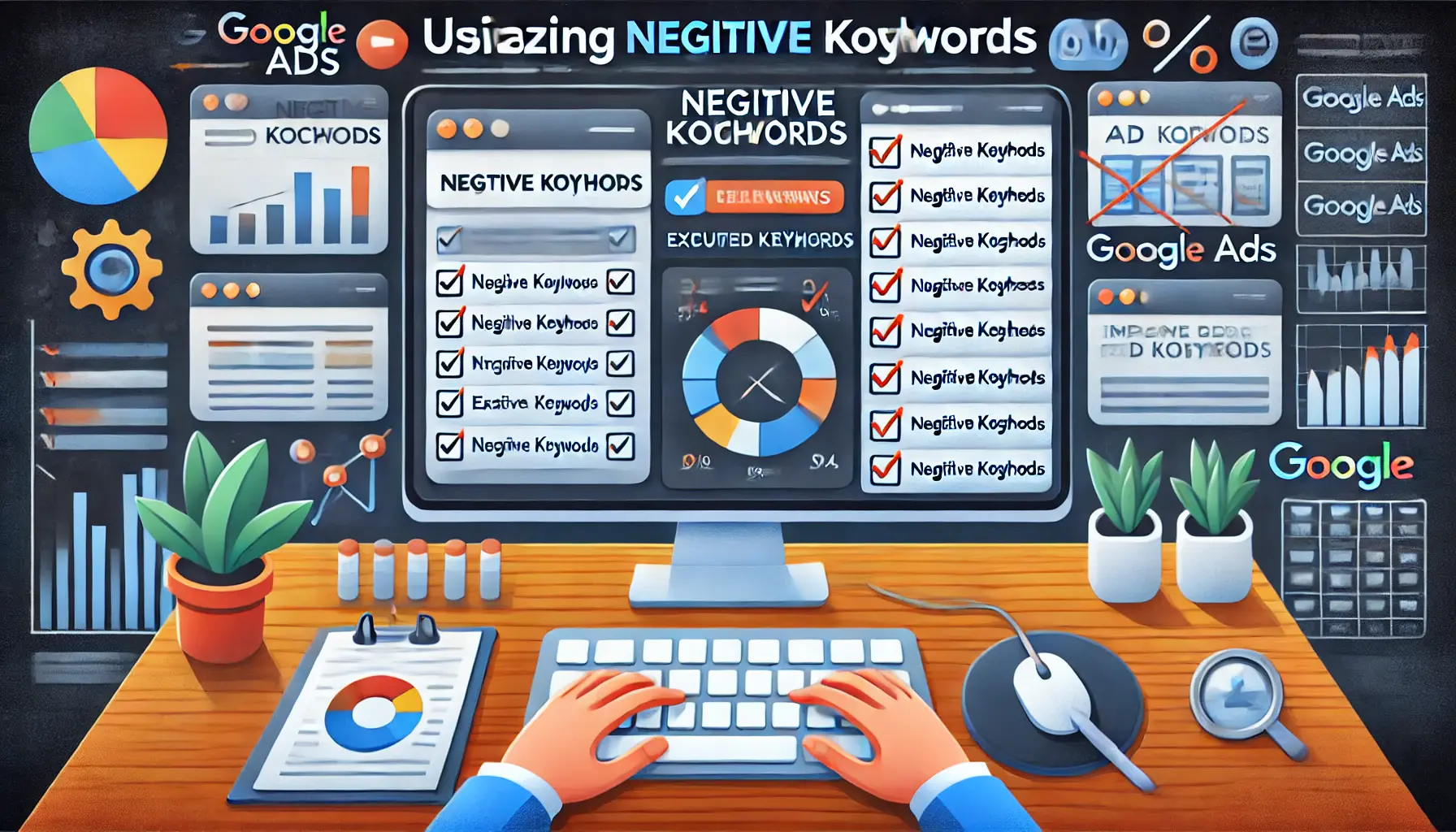Keyword research forms the bedrock of every successful Google Ads campaign.
It is the process of finding the right words and phrases your target audience uses to search for products, services, or information online.
Without proper keyword research, even the best-designed ad will not be able to achieve its full potential.
The right keywords help ensure that your ads appear in front of the right people, at the right time, and in the right context.
This guide will take you through the essentials of keyword research for Google Ads, providing actionable tips and strategies to enhance your campaigns and maximize your advertising budget.
- What is Keyword Research and Why is it Essential for Google Ads?
- How to Do Effective Keyword Research for Google Ads
- Advanced Strategies for Keyword Research in Google Ads
- Tools and Resources for Optimizing Google Ads Keyword Research
- Integrating Keyword Research into Your Google Ads Campaign
- Conclusion: How to Ace Keyword Research for Google Ads Success
- Google Ads Keyword Research FAQs
What is Keyword Research and Why is it Essential for Google Ads?
Keyword research is the process of determining and analyzing the search terms people enter while looking for something online.
In relation to Google Ads, it helps advertisers understand how their audience uses language and serves as a roadmap to create targeted, relevant, and effective ad campaigns.
Without proper keyword research, you risk targeting the wrong audience, leading to poor ad performance and wasted budget.

Grasping the Fundamental Concepts of Keyword Research.
Understanding the Basics
At its core, keyword research is about discovering the phrases your potential customers are typing into search engines.
Keywords act as a bridge between what people are searching for and what your business is offering.
By focusing on the right keywords, you can create highly relevant ads that connect with your audience and yield higher click-through rates (CTR) and conversions.
For example, when a user searches for ‘best digital marketing tools’ and your ad has that keyword, your ad might appear at the top of their search results.
This shows why selecting the right keywords is crucial for effective targeting and reaching the right audience.
- Broad Match: Your ad appears for searches containing similar or related terms.
- Phrase Match: Your ad appears when the search query matches the keyword phrase exactly or includes additional words.
- Exact Match: Your ad appears only when the search query is an exact match for your keyword.

Understanding How Keyword Research Affects Ad Performance.
Impact on Ad Performance
Using relevant keywords helps you reach users who are more likely to engage with your ad, raising your CTR and improving your Quality ScoreA metric used by Google Ads to determine ad relevance and impact on performance..
Google rewards well-targeted ads by giving them higher placements and lowering your cost per click (CPC).
On the other hand, irrelevant or overly broad keywords can quickly drain your budget without delivering results.

Identifying Frequent Pitfalls in Keyword Research.
Common Mistakes in Keyword Research
Many advertisers make common mistakes in keyword research.
One of the biggest errors is choosing keywords that are too broad or too competitive, which can lead to wasted ad spend as you compete with larger businesses.
Another common mistake is failing to regularly update and refine your keywords based on performance data.
Remember, keyword research is a continuous process that requires ongoing attention.
- Choosing overly broad keywords.
- Ignoring long-tail keywords with lower competition.
- Not using negative keywords to filter irrelevant traffic.
- Failing to track and adjust keyword performance over time.
Keyword research is the foundation of a successful Google Ads campaign, as it aligns audience intent with your ads for better targeting and performance.

Strategies for Conducting Effective Keyword Research.
How to Do Effective Keyword Research for Google Ads
Conducting effective keyword research is a vital aspect when creating optimized Google Ads campaigns.
You want to find the keywords that your target audience is actually searching for while striking a balance between relevance, competition, and cost.
In fact, Google Ads runs on data-driven keyword selection, so researching the best choices becomes an ultimate necessity.
This section will walk you through the major ways to discover the best keywords for your campaigns.

Harnessing Google Keyword Planner for Effective Keyword Research.
Using Google Keyword Planner
Google Keyword Planner is a fundamental tool for keyword research.
It helps advertisers find new keyword ideas based on search volume, competition, and suggested bids.
By using a few of your seed keywords or phrases pertinent to your business, this tool generates keyword ideas that align with the search habits of your target audience.
This is a perfect way to start identifying relevant keywords that can drive traffic to your ads.
- Get new keyword ideas: Enter a few simple keywords, and Keyword Planner gives you a list of similar search terms that could work for your campaign.
- Get metrics for keywords: Review search volume, competition levels, and cost estimates to evaluate the potential of each keyword.
- Get realistic bids: Keyword Planner provides bid suggestions based on the popularity of each keyword, helping you manage your budget effectively.

Analyzing Competitor Keywords for Strategic Advantage.
Competitor Keyword Analysis
Analyzing competitor keywords can help you understand what keywords your competitors are bidding for.
Tools like SEMrushA paid tool for competitor analysis and keyword research., AhrefsA paid tool for keyword research, backlink analysis, and SEO tracking., or SpyFuA tool for analyzing competitor keywords and ad strategies. allow you to track competitors’ keyword strategies.
These tools show you which keywords they are targeting, the search volume of those keywords, and how much they are spending on ads.
Analyzing their strategies helps you identify opportunities or gaps in your own keyword strategy.
- Identify gaps: Discover keywords that your competitors are targeting but you may have missed.
- Find low-competition keywords: Focus on keywords with less competition where you can compete more effectively.
- Refine your strategy: Adjust your bids, focus on high-performing keywords, and stay competitive in the market.

Understanding the Differences Between Long-Tail and Short-Tail Keywords.
Long-Tail vs Short-Tail Keywords
Understanding long-tail and short-tail keywordsBroad, general search terms that usually have high search volumes and competition. is crucial to conducting effective keyword research.
Short-tail keywords are general terms like ‘digital marketing,’ which usually have high search volumes and stiff competition.
Long-tail keywords, such as ‘best digital marketing tools for small businesses,’ are more specific and tend to have lower search volumes but less competition, resulting in a higher chance of conversion.
- Short-tail keywords: Broad terms with a large reach but more competitive and costly.
- Long-tail keywords: Specific phrases with lower search volumes but easier to rank for and better conversion rates.
- Balance your strategy: A combination of long-tail and short-tail keywords creates a balanced and effective campaign.

Strategizing Keyword Research Based on Search Intent.
Optimizing for Search Intent
Keyword success depends on understanding user intent behind search queries.
Search intent can be categorized into informational, navigational, and transactional.
When researching keywords, it’s important to align your keywords with what the user intends to do.
Are they looking for information, navigating to a particular site, or ready to make a purchase?
Matching your keywords to user intent helps create more effective ads that resonate with your audience.
- Informational intent: Keywords used when users are seeking knowledge (e.g., ‘how to improve Google Ads campaigns’).
- Navigational intent: Keywords used to find a specific website or page (e.g., ‘Google Ads login’).
- Transactional intent: Keywords used when users are ready to make a purchase or take action (e.g., ‘buy Google Ads services’).
By focusing on the intent behind your chosen keywords, you can tailor your ads to better meet the needs of your audience, leading to higher click-through rates and conversions.
Balancing relevance, competition, and cost during keyword research is crucial for optimizing your Google Ads campaigns.

Exploring Advanced Techniques for Effective Keyword Research.
Advanced Strategies for Keyword Research in Google Ads
Once you’ve mastered the basics of keyword research in Google Ads, it’s time to dive into advanced strategies that will elevate your campaigns to the next level.
These methodologies help you narrow down your keyword lists to avoid wasted ad spend on targeting the wrong audience.
By implementing advanced techniques like negative keywordsKeywords that prevent your ad from being shown for irrelevant search queries., search query analysisThe process of reviewing the actual search terms users type in before clicking on your ad., and seasonal keyword trends, you can achieve much better results in your campaigns.
These strategies enhance efficiency and effectiveness.

The Importance of Negative Keywords in Google Ads Campaigns.
Utilizing Negative Keywords
For instance, if you sell luxury goods, you need to exclude search results that contain terms like ‘free’ or ‘cheap’ by adding them as negative keywords.
This ensures that your ads are only shown to users who are more likely to convert.
Negative keywords improve targeting by refining who sees your ads through the exclusion of irrelevant searches.
- Save budget: Exclude irrelevant clicks, helping you avoid wasting money on users unlikely to convert.
- Boost Quality Score: Google rewards more relevant ads with a higher Quality Score, which can lower your cost per click and improve ad position.

Enhancing Keyword Effectiveness Through Search Query Insights.
Refining Keywords Through Search Query Analysis
Another advanced strategy is conducting a search query analysis.
This means reviewing the actual search terms users typed in before clicking on your ad.
You can use this data to find new keyword opportunities and further refine your existing keyword list.
Search query analysis helps you understand how people are finding your ads and whether your current keywords capture the right audience.
- Identify new keyword opportunities: Search query data helps you discover keywords you may not have considered before.
- Refine bidding: Based on the performance of different search queries, adjust your bidding strategy accordingly.
- Exclude irrelevant queries: Add irrelevant search terms as negative keywords to improve targeting.

Understanding Seasonal Trends for Effective Keyword Strategy.
Leveraging Seasonal Keyword Trends
One of the most integral parts of keyword performance is seasonal trends.
You can analyze how keyword popularity fluctuates throughout the year, allowing you to adjust your campaigns to capitalize on demand when it’s at its highest.
Tools like Google TrendsA tool that shows the popularity of keywords over time and helps identify seasonal trends. can help you identify these patterns, enabling you to create more relevant campaigns during peak seasons.
- Optimize timing: Run your campaigns during peak search times to capture higher traffic.
- Prepare for seasonality: Adjust your keyword strategy in anticipation of seasonal trends to maximize increased demand.
- Analyze past performance: Review past data to predict future trends and adjust your keyword bids and strategies accordingly.

Using Data to Drive Ongoing Improvements in Digital Marketing.
Leveraging Data for Continuous Improvement
Finally, effective keyword research is an ongoing process.
Continuously rethink your keyword strategy based on performance data.
Tracking key metrics like click-through rates (CTR), conversion rates, and cost-per-click (CPC) helps you make informed decisions about which keywords to retain, adjust, or remove.
This data-driven approach ensures continuous improvement of your Google Ads campaigns.
- Track performance metrics: Monitor CTR, conversion rates, and other key performance indicators.
- Test new keywords: Run experiments with new keyword ideas based on data and performance insights.
- Adjust bids: Focus on high-performing keywords and reduce spending on underperforming ones.
By applying these advanced strategies, you can refine your keyword research process, minimize waste, and improve the overall effectiveness of your Google Ads campaigns.
Negative keywords, search query analysis, and seasonal trends help refine targeting and minimize wasted ad spend.

Essential Tools for Effective Keyword Research in Google Ads.
Tools and Resources for Optimizing Google Ads Keyword Research
An effective Google Ads campaign requires the application of the right tools and resources for keyword research.
These tools help you discover new opportunities, analyze competitors, and continuously optimize your keywords.
Whether you prefer free or paid tools, there are several that can dramatically improve your campaign’s effectiveness.
In this section, we will explore some of the most useful tools available to optimize your keyword research.

Comparing Free and Paid Tools for Keyword Research.
Free vs Paid Keyword Research Tools
Among keyword research tools, some are free, while others require a paid subscription.
Each category has its pros and cons.
Free tools, such as Google Keyword PlannerA free tool provided by Google Ads to help advertisers find relevant keywords. and UbersuggestA free tool providing keyword suggestions and basic SEO insights., provide basic data like search volume and competition for the main keyword.
While free tools offer simple insights, paid tools like Ahrefs, SEMrush, and Moz provide more advanced metrics, such as backlink data, competitor analysis, and keyword difficulty scores.
Combining both free and paid tools can help you make comprehensive keyword research, depending on your budget and needs.
- Google Keyword Planner (Free): Offers search volume, competition level, and keyword suggestions directly from Google Ads.
- Ubersuggest (Free): Provides basic keyword suggestions, search volume, and SEO insights.
- SEMrush (Paid): Powerful for competitor analysis, keyword difficulty, and keyword tracking.
- Ahrefs (Paid): Advanced analysis of backlinks, organic search traffic, and keyword rankings.
- Moz (Paid): Provides keyword difficulty scores and comprehensive SEO tracking.

Exploring Keyword Popularity Through Google Trends.
Google Trends and Insights
Google Trends can be vital in showing how keyword popularity changes over time.
By analyzing past data, you can identify rising trends, seasonality, and how to adjust your campaigns to match user behavior.
Google Trends is particularly useful for identifying emerging keywords with low competition, allowing you to target them early and gain a competitive advantage.
- Discover rising trends: Identify which keywords are gaining traction over time.
- Analyze seasonality: Understand how certain keywords perform better during specific times of the year.
- Regional insights: Determine which keywords are popular in specific geographic areas.

Utilizing Advanced Tools for Comprehensive Keyword Analysis.
Third-Party Tools for Deep Analysis
For those looking to take their keyword research to the next level, third-party tools like SpyFu, WordStream, and KeywordTool.io offer advanced features beyond basic keyword suggestions.
These tools allow you to conduct competitor research, monitor keyword rankings, and generate new keyword ideas based on real search behavior.
They also provide detailed reports on your competitors’ ad strategies to help you refine your own approach.
- SpyFu: Analyzes your competitors’ keywords and ad performance, offering insights to further optimize your campaigns.
- WordStream: Provides keyword suggestions and performance data to help optimize your PPC campaigns.
- KeywordTool.io: Generates long-tail keyword ideas using autocomplete data from Google, YouTube, Amazon, and more.
Analyzing Key Performance Metrics for Effective Campaign Management.
Tracking Performance Metrics
Finding good keywords isn’t enough—you also need to track how well those keywords are performing over time.
Tools like Google Analytics and the reporting features within Google Ads allow you to track key performance metrics like CTR, conversion rates, and ROI.
By monitoring these metrics, you can identify which keywords are driving the most value for your business and make data-driven adjustments to improve your campaigns.
- Google Analytics: Provides detailed data on user behavior, conversions, and traffic sources related to your keywords.
- Google Ads Reporting: Track keyword performance, including CTR and Quality Score, within your Google Ads dashboard.
- Other Analytics Tools: Tools like Kissmetrics and Mixpanel offer detailed insights into user behavior and conversions.
The right combination of free and paid tools, along with Google’s offerings, will help you optimize your keyword research and continuously improve the performance of your Google Ads campaigns.
Using a combination of free and paid tools, like Google Keyword Planner and SEMrush, enhances keyword research effectiveness.

Strategizing Keyword Integration for Effective Google Ads Campaigns.
Integrating Keyword Research into Your Google Ads Campaign
After completing your keyword research, the next step involves integrating those keywords into your Google Ads campaign.
Proper integration ensures that your ads are highly relevant to your target audience, which can increase click-through rates (CTR) and conversions.
This section covers how to group keywords, write engaging ad copy, set bids appropriately, and monitor performance for ongoing optimization.

Structuring Keywords for Effective Ad Group Management.
Organizing Keywords into Ad Groups
One of the first steps in incorporating keywords into your Google Ads campaign is organizing them into themed ad groups.
Grouping similar keywords together enables you to create ads that are more relevant to specific searches.
This helps improve ad relevance and Quality Score, which ultimately lowers your cost per click (CPC).
By aligning your keywords with relevant ad copy and landing pages, you can further improve your Quality Score.
- Align keywords with ad groups: Group similar keywords into focused ad groups to create more targeted ads.
- Improve Quality Score: Google rewards ads that are closely related to their keywords with better ad placements and lower costs.

Crafting Compelling Ad Messages for Google Ads.
Creating Effective Ad Copy
Writing effective ad copy is critical for engaging your audience.
Your ads should clearly state the benefits of your product or service and include a strong call-to-action (CTA).
It’s essential to include the primary keywords of each ad group in the headlines and descriptions to enhance ad relevance and boost your Quality Score.
- Primary keyword usage: Use primary keywords from your ad groups in the headlines and descriptions of your ads.
- Clearly state benefits: Highlight the benefits of your product or service in your ad copy.
- Use strong CTAs: Encourage users to take action with phrases like “Buy now” or “Get started today.”

Strategic Bid Setting for Maximizing Keyword Performance.
Setting Bids Based on Keyword Value
Setting bids determines how often and where your ads appear in search results.
It’s important to set your bids based on the value of each keyword.
For example, keywords with high commercial intent—where users are likely ready to make a purchase—should generally have higher bids, while informational keywords may warrant lower bids.
- Assign higher bids: Prioritize keywords that are more likely to result in conversions by assigning higher bids.
- Adjust bids over time: Update your bids to focus on continuously high-performing keywords.
- Utilize automated bidding: Automated bidding strategies, such as Target CPA, can optimize your bids for performance.

Analyzing Performance Metrics for Strategic Adjustments.
Measuring Success and Adjusting Strategy
Once your campaign goes live, it’s essential to monitor performance and make data-driven adjustments.
Google Ads provides various metrics, such as CTR, conversion rate, and return on investment (ROI), that indicate whether your keyword strategy is working.
Use this data to refine your keywords, adjust bids, and improve ad copy for continuous improvements.
- Monitor key metrics: Track CTR, conversion rates, and ROI to measure campaign success.
- Refine keywords: Periodically review keyword performance and make adjustments to improve targeting.
- Optimize ad copy: Continuously test and refine your ad copy to align with user intent and drive conversions.
By effectively incorporating keyword research into your Google Ads campaign, you can create highly targeted ads, optimize your budget, and ultimately improve overall campaign performance.
Organizing keywords into themed ad groups improves ad relevance, Quality Score, and overall campaign efficiency.

Celebrating Success in Keyword Research for Google Ads.
Conclusion: How to Ace Keyword Research for Google Ads Success
Keyword research lies at the foundation of every successful Google Ads campaign.
If you can identify what exactly your targeted audience needs and select relevant keywords, you take a giant step toward making your ads more effective.
This article has walked you through the core aspects of conducting keyword research for your Google Ads, from basic techniques to advanced strategies, while offering insights on how to incorporate keywords into your campaigns for optimal results.

Highlighting the Significance of Organized Keyword Research Strategies.
The Importance of Structured Keyword Research
As discussed, keyword research begins by determining the search terms your audience uses.
You can identify which keywords best fit your business goals and user intent by leveraging tools such as Google Keyword Planner, Google Trends, or third-party suites like Ahrefs or SEMrush.
Structuring your keywords into focused ad groups, refining bids, and crafting ad copy provide a strong foundation for your campaigns.
Proper grouping of keywords into ad groups ensures that the ads triggered by them are highly relevant to search queries.
This improves ad relevance and lowers your cost-per-click (CPC).
Integrating primary keywords into your ad copy increases the likelihood of attracting clicks from users actively searching for products or services like yours.

Utilizing Advanced Techniques to Improve Keyword Research Strategies.
Advanced Techniques Enhance Keyword Research
Beyond basic keyword research, advanced techniques such as utilizing negative keywords, conducting search query analysis, and monitoring seasonal trends can further refine your targeting.
Negative keywords help eliminate irrelevant traffic, while search query analysis reveals new opportunities to improve your keyword strategy.
Leveraging seasonal trends ensures your campaigns remain competitive during peak search periods.
- Negative keywords: Refine targeting by excluding irrelevant searches that could waste your budget.
- Search query analysis: Unlock new keyword opportunities to modify bids for improved performance.
- Seasonal trend alignment: Ensure your keyword strategy aligns with high-traffic periods for maximum visibility.

Dedicated to Continuous Optimization for Enhanced Performance.
Continuously Optimize for Better Results
Keyword research is not a one-time task; it’s an ongoing process that requires constant attention.
While your campaigns are running, it is crucial to continuously monitor key performance metrics such as CTR, conversion rate, and ROI.
Doing so allows you to refine your keyword strategy, adjust bids, test new ad copy, and enhance overall performance.
Automated bidding tools can further simplify this process by optimizing your budget to focus on high-performing keywords.

Strategic Integration of Keyword Research in Marketing Campaigns.
Integrating Keyword Research into Campaigns
A well-thought-out integration of keyword research into your Google Ads campaigns is essential for success.
Organize your keywords into ad groups, craft appealing ad copy, set your bids based on keyword value, and systematically track your performance to make data-driven decisions that will keep your campaigns competitive.
This ensures your ads remain relevant to your target audience and that your campaigns are optimized for maximum effectiveness.

Reflecting on Success in Keyword Research for Google Ads.
Conclusion
Keyword research is a powerful tool that enhances the effectiveness of your Google Ads campaigns.
By continuously refining your approach, staying updated on trends, and using the right set of tools, you can devise a Google Ads campaign that delivers significant results, maximizing both your return on investment (ROI) and the overall impact of your marketing efforts.
Consistently refining your keyword research and staying updated on trends ensures the long-term success of your Google Ads campaigns.

Exploring Frequently Asked Questions on Keyword Research.
Your campaigns can be managed by an agency specialized in Google Ads, check out our service page.
Google Ads Keyword Research FAQs
Below are some of the frequently asked questions about keyword research in Google Ads, how it impacts campaign success, and important tips to help you optimize your campaign and improve overall ad performance.
Keyword research in Google Ads involves identifying the search terms people use when looking for products or services.
This helps advertisers create focused ad campaigns that improve click-through rates (CTR) and conversions.
Keyword research ensures your ads reach the right audience, improving relevance and ad performance.
By targeting the right keywords, you increase the chances of higher CTR, better Quality Scores, and more conversions.
Popular tools include Google Keyword Planner, SEMrush, Ahrefs, and Ubersuggest.
These tools provide insights into search volume, keyword difficulty, competition, and help identify new keyword opportunities for your Google Ads campaigns.
Negative keywords prevent your ads from appearing in irrelevant searches.
By adding them to your campaign, you exclude certain search terms, reducing wasted ad spend and improving ad relevance.
Regularly review and update your keyword strategy based on key performance indicators such as CTR, conversion rates, and keyword competition.
This process ensures your campaigns stay relevant in changing market conditions.
Long-tail keywords are longer phrases with lower search volume but less competition.
They are important because they are easier to rank for and typically have higher conversion rates, making them valuable for targeted advertising.
Group keywords into ad groups based on similar themes or topics.
By grouping related keywords together, you create more relevant ads, improve Quality Score, and enhance overall campaign performance.












